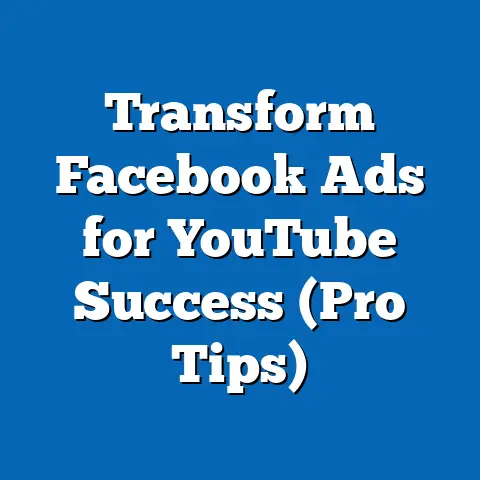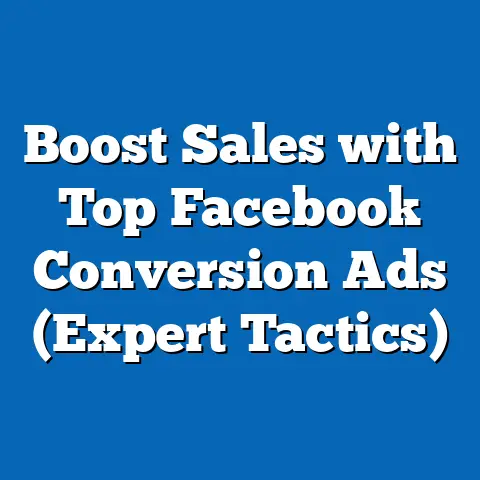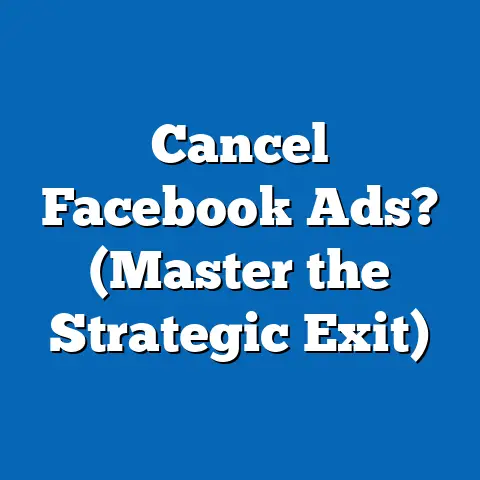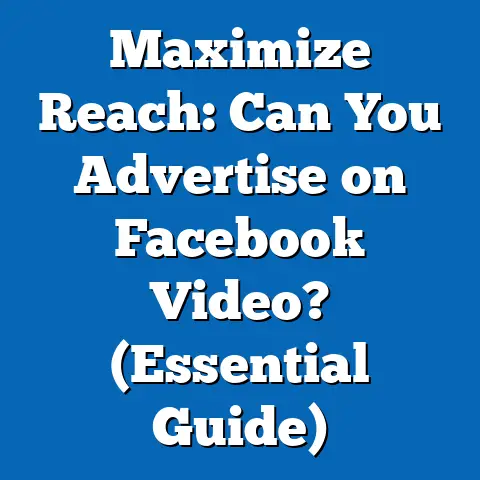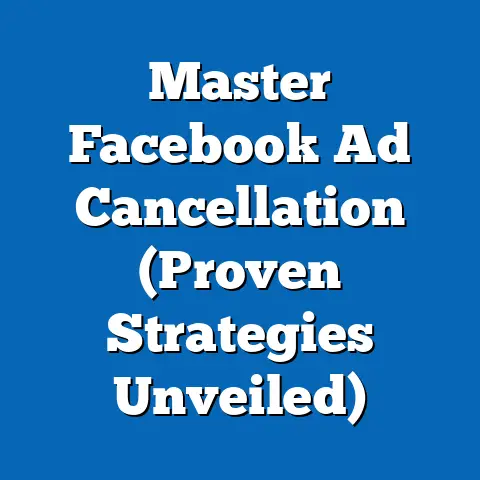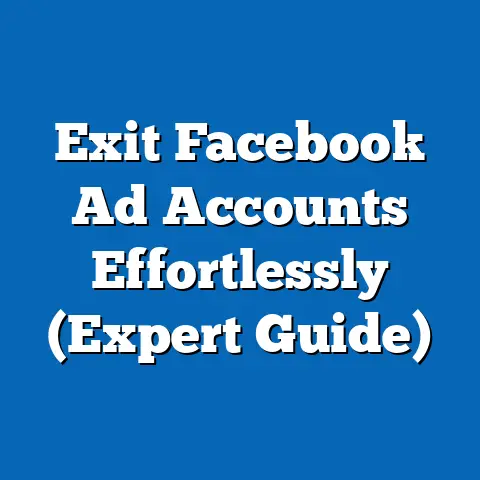Eradicate Facebook Hoaxes (Proven Strategies for Marketers)
The digital landscape, particularly Facebook, has become a breeding ground for misinformation. Hoaxes, fake news, and misleading advertisements spread like wildfire, impacting not just individual users but also brands and marketers who rely on the platform to connect with their audience. It’s estimated that misinformation can reach as many as 158 million Americans, according to a 2022 study by the Knight Foundation. This pervasive spread of false information can erode brand reputation, diminish customer trust, and ultimately, damage the bottom line.
I’ve seen firsthand how a single hoax, even one tangentially related to a brand, can trigger a cascade of negative reactions. A client of mine, a local bakery, suffered a dip in sales when a fake news article circulated claiming they used artificial ingredients, despite clear labeling to the contrary. The damage was significant, and recovering that trust took months of concerted effort.
But it’s not all doom and gloom. Marketers have the power to combat these hoaxes effectively, and a key weapon in their arsenal is bold design. Bold design isn’t just about aesthetics; it’s about communicating trustworthiness, credibility, and authenticity in a visually compelling way. It’s about cutting through the noise and making a statement that resonates with your audience.
Think of it like this: in a sea of blurry, poorly designed images and clickbait headlines, a clean, impactful, and well-designed ad stands out. It signals professionalism and attention to detail, subconsciously telling your audience that you care about quality and accuracy.
- Understanding the anatomy of Facebook hoaxes and why they spread.
- The power of bold design in capturing attention and building trust.
- Proven strategies for marketers to create trustworthy content, engage with their audience, and utilize Facebook’s tools effectively.
- Real-world case studies of brands that have successfully combatted misinformation.
By the end of this article, you’ll have the knowledge and tools you need to protect your brand from the damaging effects of Facebook hoaxes and build a stronger, more authentic connection with your audience. So, let’s dive in and arm ourselves against the tide of misinformation!
Section 1: Understanding Facebook Hoaxes
Before we can effectively combat Facebook hoaxes, we need to understand what they are, why they spread, and the damage they can cause.
What is a Facebook Hoax?
A Facebook hoax is any piece of false or misleading information that is intentionally or unintentionally spread on the platform. These can take many forms, including:
- Fake News: Fabricated news stories designed to mimic legitimate journalism, often with the goal of influencing public opinion or generating clicks. I remember seeing a particularly egregious example during the last election cycle, where a completely fictitious story about a candidate’s personal life went viral, impacting their public image significantly.
- Misleading Advertisements: Ads that promote products or services with false claims, deceptive tactics, or exaggerated results. Think “miracle weight loss pills” or “get rich quick” schemes.
- Chain Letters and Scams: Messages that encourage users to share them with their contacts, often promising rewards or threatening negative consequences if they don’t comply. These often exploit users’ fears or vulnerabilities.
- Impersonation Accounts: Fake profiles created to impersonate real people or organizations, often with the intent of spreading misinformation or engaging in fraudulent activities.
- Manipulated Images and Videos: Altered or out-of-context visuals used to create a false narrative or deceive viewers. Deepfakes, while still relatively rare, are becoming increasingly sophisticated and pose a significant threat.
The Psychology Behind Hoax Propagation
Understanding the psychological factors that drive the spread of hoaxes is crucial for crafting effective counter-strategies. Several key factors contribute to why people engage with and share misinformation:
- Confirmation Bias: People tend to seek out and believe information that confirms their existing beliefs, even if that information is false. This makes them more likely to share hoaxes that align with their worldview.
- Emotional Appeal: Hoaxes often exploit emotions like fear, anger, or excitement to grab attention and encourage sharing. A shocking headline or a heart-wrenching image can bypass critical thinking and trigger an immediate emotional response.
- Social Proof: People are more likely to believe something if they see that others are also believing it. The more shares and likes a hoax receives, the more credible it appears, even if it’s completely false.
- Lack of Critical Thinking: Many users don’t take the time to verify the accuracy of information before sharing it, especially if it seems plausible or aligns with their existing beliefs.
- Algorithmic Amplification: Facebook’s algorithms can inadvertently amplify the reach of hoaxes by prioritizing engagement over accuracy. Content that generates a lot of clicks, shares, and comments is often pushed to more users, regardless of its veracity.
Implications for Businesses and Marketers
The spread of Facebook hoaxes can have devastating consequences for businesses and marketers:
- Loss of Brand Reputation: Being associated with misinformation, even indirectly, can damage your brand’s reputation and erode customer trust.
- Decreased Customer Trust: If customers believe that you are sharing or condoning false information, they are less likely to trust your products, services, and marketing messages.
- Negative Customer Sentiment: Hoaxes can spark outrage and negative sentiment towards your brand, leading to negative reviews, social media backlash, and boycotts.
- Reduced Engagement: Users who feel they have been misled are less likely to engage with your content in the future.
- Financial Losses: Damaged reputation and decreased customer trust can translate into lost sales and revenue.
- Legal Repercussions: In some cases, spreading false or misleading information can have legal consequences, particularly if it harms individuals or organizations.
The Role of Visuals in Spreading Misinformation
Visuals play a crucial role in the spread of misinformation. A compelling image or video can make a hoax seem more credible, even if the underlying information is false. Poorly designed visuals, on the other hand, can signal untrustworthiness. That’s where the power of bold design comes in.
Bold design can counteract the spread of misinformation by:
- Capturing Attention: A visually striking ad or post is more likely to grab attention in a crowded newsfeed, giving you the opportunity to present accurate information.
- Communicating Credibility: Clean, professional design signals trustworthiness and attention to detail.
- Enhancing Message Clarity: Bold design can help you communicate your message clearly and effectively, reducing the risk of misinterpretation.
- Building Trust: Consistent use of bold design elements can help build a strong brand identity and foster customer trust.
Takeaway: Understanding the nature of Facebook hoaxes, the psychology behind their spread, and the implications for your brand is the first step in developing an effective counter-strategy. Recognizing the power of visuals and the potential of bold design is key to cutting through the noise and building a trusted brand presence.
Section 2: The Power of Bold Design in Marketing
Now that we understand the threat posed by Facebook hoaxes, let’s explore how bold design can be a powerful weapon in your marketing arsenal.
What is Bold Design?
Bold design isn’t just about using bright colors or flashy graphics. It’s about making a statement, capturing attention, and communicating your message with clarity and impact. In the context of Facebook ads and posts, bold design means:
- Visually Striking: Using elements that immediately grab the viewer’s attention.
- Memorable: Creating visuals that are easily remembered and associated with your brand.
- Communicating Authenticity: Conveying your brand’s personality and values in a genuine and relatable way.
- Instilling Trust: Projecting professionalism, competence, and reliability.
- Being Intentional: Every design choice should have a purpose and contribute to the overall message.
I’ve always believed that good design is invisible. It seamlessly guides the viewer’s eye, making the message easy to understand and remember. Bold design, however, is intentionally visible. It demands attention and makes a statement.
Elements of Bold Design
Several key elements contribute to bold design:
- Color Choice: Using a limited palette of bold, contrasting colors to create visual impact. Think of brands like Netflix (red and black) or Target (red and white).
- Typography: Selecting fonts that are both legible and expressive, and using them strategically to create emphasis and hierarchy. Experiment with different font weights, sizes, and styles to make your message stand out.
- Imagery: Using high-quality, authentic images and videos that resonate with your target audience. Avoid generic stock photos and opt for visuals that showcase your brand’s personality and values.
- Layout and Composition: Creating a visually balanced and engaging layout that guides the viewer’s eye and highlights key information. Use whitespace effectively to avoid clutter and improve readability.
- Branding Consistency: Maintaining a consistent brand identity across all your Facebook ads and posts. This includes using the same logo, colors, fonts, and imagery to create a recognizable and trustworthy brand presence.
Examples of Brands Using Bold Design Effectively
Let’s look at some examples of brands that effectively use bold design on Facebook:
- Nike: Nike’s ads are often characterized by striking visuals, bold typography, and a focus on athletic performance. Their use of black and white photography, combined with pops of vibrant color, creates a sense of energy and dynamism.
- Apple: Apple’s ads are known for their minimalist design, clean typography, and high-quality product photography. They focus on showcasing the simplicity and elegance of their products.
- Dove: Dove’s “Real Beauty” campaign is a prime example of using bold design to promote a message of body positivity and self-acceptance. Their ads feature diverse women of all shapes and sizes, challenging traditional beauty standards.
- Innocent Drinks: This UK-based smoothie company uses a playful and quirky design style that reflects its brand personality. Their ads are full of bright colors, hand-drawn illustrations, and witty copy.
These brands demonstrate that bold design can be used effectively across a wide range of industries and brand personalities. The key is to be authentic, intentional, and consistent in your approach.
Linking Bold Design to Reducing Hoax Propagation
Bold design can directly reduce the likelihood of hoax propagation by:
- Increasing Credibility: A well-designed ad or post signals professionalism and attention to detail, making it more likely that viewers will trust the information being presented.
- Improving Clarity: Bold design can help you communicate your message clearly and effectively, reducing the risk of misinterpretation and preventing the spread of misinformation.
- Enhancing Engagement: Visually appealing content is more likely to capture attention and encourage engagement, giving you the opportunity to present accurate information and counter hoaxes.
- Building Brand Loyalty: Consistent use of bold design elements can help build a strong brand identity and foster customer loyalty, making your audience more likely to trust your brand and dismiss misinformation.
Takeaway: Bold design is a powerful tool for capturing attention, communicating credibility, and building trust on Facebook. By incorporating bold design elements into your ads and posts, you can effectively counter the spread of hoaxes and build a stronger, more authentic brand presence.
Section 3: Proven Strategies for Marketers to Combat Hoaxes
Now that we understand the power of bold design, let’s delve into specific strategies you can implement to combat Facebook hoaxes and protect your brand.
Subsection 3.1: Create Trustworthy Content
The foundation of any successful anti-hoax strategy is creating content that is inherently trustworthy. This means prioritizing accuracy, transparency, and authenticity in everything you do.
- Fact-Checking and Sourcing Credible Information: Before sharing any information, take the time to verify its accuracy. Consult multiple reputable sources, such as academic journals, government reports, and established news organizations. Avoid relying on unverified sources or social media posts.
- Incorporate Bold Design While Maintaining Credibility: Use bold design elements to capture attention, but don’t sacrifice credibility in the process. Avoid sensationalist headlines, exaggerated claims, and misleading visuals. Instead, focus on creating a clean, professional design that enhances the trustworthiness of your message.
- Use Testimonials and User-Generated Content: Testimonials and user-generated content can be powerful tools for building trust and authenticity. Feature real customers sharing their positive experiences with your brand. Encourage users to share their own content related to your products or services.
- Be Transparent About Your Sources: Clearly cite your sources and provide links to reputable websites and publications. This demonstrates that you have done your research and are committed to providing accurate information.
- Admit Mistakes and Correct Errors: If you make a mistake, own up to it and correct it promptly. This shows that you are honest and accountable, and it can actually strengthen your relationship with your audience.
- Focus on Providing Value: Create content that is informative, helpful, and relevant to your target audience. This will not only build trust but also establish you as a thought leader in your industry.
I’ve found that being upfront and honest with my audience, even when it’s difficult, goes a long way in building trust. One time, I had to retract a statement I made in a blog post because I had misinterpreted some data. I issued a correction, explained my mistake, and apologized to my readers. To my surprise, many people thanked me for my honesty and transparency.
Subsection 3.2: Engage with Your Audience
Engaging with your audience is crucial for building a strong community and fostering a culture of truth and transparency.
- Create Interactive Posts: Encourage dialogue and critical thinking by creating interactive posts that ask questions, solicit opinions, or invite users to share their own experiences.
- Run Polls and Quizzes: Polls and quizzes are a fun and engaging way to gather feedback from your audience and spark conversation. You can use them to test their knowledge, gauge their opinions, or simply entertain them.
- Host Live Videos and Q&A Sessions: Live videos and Q&A sessions are a great way to connect with your audience in real-time and build brand authority. Invite experts to discuss relevant topics, answer questions from viewers, and share valuable insights.
- Respond to Comments and Messages: Promptly respond to comments and messages from your audience. Acknowledge their feedback, answer their questions, and address their concerns.
- Encourage Civil Discourse: Create a safe and respectful environment for dialogue. Moderate comments and remove any that are offensive, hateful, or misleading.
- Address Misinformation Directly: If you see misinformation being shared on your page or in your comments section, address it directly and provide accurate information. Don’t be afraid to challenge false claims and set the record straight.
I once hosted a live Q&A session with a panel of industry experts to address common misconceptions about a particular product. The session was incredibly successful, and we received a flood of positive feedback from viewers who appreciated the opportunity to learn from the experts and have their questions answered.
Subsection 3.3: Utilize Facebook’s Tools and Features
Facebook offers a range of tools and features that can help you combat hoaxes and protect your brand.
- Leverage Facebook’s Verification Tools: If you are a public figure, journalist, or organization, consider getting your Facebook page verified. This will help users distinguish your official page from fake impersonation accounts.
- Use Reporting Features: If you encounter content that violates Facebook’s Community Standards, report it immediately. This includes fake news, misleading advertisements, hate speech, and other forms of harmful content.
- Create Educational Content: Inform your audience about how to recognize hoaxes and identify false information. Share tips on how to verify sources, spot misleading headlines, and avoid falling for scams.
- Use Facebook Groups: Create a Facebook group for your brand and foster a culture of truth and transparency. Moderate the group to ensure that discussions are respectful and accurate.
- Monitor Your Brand Mentions: Use Facebook’s search function to monitor mentions of your brand. This will help you identify any instances of misinformation or negative sentiment.
- Utilize Facebook’s Ad Library: Use the Ad Library to research your competitors’ ads and identify any potentially misleading or deceptive advertising practices.
Subsection 3.4: Implement Monitoring and Response Strategies
Even with the best preventative measures in place, hoaxes can still slip through the cracks. That’s why it’s essential to have a robust monitoring and response strategy in place.
- Monitor Brand Mentions: Continuously monitor brand mentions across Facebook to detect hoaxes quickly. Use tools like Facebook Search, Mention, or Brand24 to track mentions of your brand name, products, and services.
- Have a Crisis Response Plan: Develop a crisis response plan that outlines the steps you will take if a hoax or misinformation campaign targets your brand. This plan should include clear roles and responsibilities, communication protocols, and strategies for addressing the issue.
- Respond to Misinformation: When you detect misinformation, respond quickly and decisively. Correct the false information with accurate facts, and explain why the original claim was incorrect.
- Maintain a Bold Brand Voice: When responding to misinformation, maintain a bold and confident brand voice. Don’t be afraid to challenge false claims and defend your brand’s reputation.
- Be Empathetic: While it’s important to be assertive, it’s also important to be empathetic. Acknowledge the concerns of your audience and address their questions and concerns with respect.
- Learn from Your Mistakes: After a crisis, take the time to review what happened and identify areas for improvement. Update your crisis response plan and refine your anti-hoax strategies based on what you learned.
Takeaway: Combating Facebook hoaxes requires a multi-faceted approach that includes creating trustworthy content, engaging with your audience, utilizing Facebook’s tools, and implementing a robust monitoring and response strategy. By adopting these proven strategies, you can protect your brand from the damaging effects of misinformation and build a stronger, more authentic connection with your audience.
Section 4: Case Studies
Let’s examine some real-world examples of brands that have successfully eradicated hoaxes or misinformation campaigns through the strategies outlined above.
- Snopes and Fact-Checking: Snopes, a fact-checking website, utilizes bold design to present accurate information and debunk hoaxes. Their website is clean, professional, and easy to navigate. They use clear and concise language, and they provide links to reputable sources to support their claims. Snopes also actively engages with its audience on social media, responding to questions and concerns and challenging false claims.
- World Health Organization (WHO): The WHO has been actively combating misinformation about COVID-19 through its social media channels. They use bold design elements, such as infographics and videos, to present accurate information in an engaging and accessible way. They also partner with social media platforms to remove false and misleading content.
- A Local Coffee Shop Combats Fake Rumors: A local coffee shop in my neighborhood was targeted by a hoax claiming they were using “low-quality” beans. The owner, instead of ignoring it, took a proactive approach. They created a visually stunning video showcasing their sourcing process, highlighting the ethical and sustainable practices they employed. They also hosted a live Q&A session with their head barista, addressing customer concerns and answering questions about their coffee beans. The video went viral, and the coffee shop saw a surge in customers who were impressed by their transparency and commitment to quality.
These case studies demonstrate that by combining bold design with proactive engagement and a commitment to accuracy, brands can effectively combat hoaxes and build a stronger, more trusted presence on Facebook.
Takeaway: Learning from the experiences of other brands can provide valuable insights and inspiration for your own anti-hoax strategies. Analyze the approaches used by successful brands and adapt them to your own unique needs and circumstances.
Conclusion
In this article, we’ve explored the pervasive threat of Facebook hoaxes and their potential impact on your brand. We’ve also examined the power of bold design and the proven strategies you can implement to combat misinformation and build a trusted brand presence.
Here’s a quick recap of the key takeaways:
- Facebook hoaxes can take many forms, including fake news, misleading advertisements, and scams.
- Understanding the psychological factors that drive the spread of hoaxes is crucial for crafting effective counter-strategies.
- Bold design can capture attention, communicate credibility, and build trust on Facebook.
- Creating trustworthy content, engaging with your audience, utilizing Facebook’s tools, and implementing a robust monitoring and response strategy are essential for combating hoaxes.
- Learning from the experiences of other brands can provide valuable insights and inspiration.
The fight against Facebook hoaxes is an ongoing battle. It requires constant vigilance, a commitment to accuracy, and a willingness to adapt your strategies as the landscape evolves. But by embracing bold design, prioritizing transparency, and engaging with your audience, you can protect your brand from the damaging effects of misinformation and build a stronger, more authentic connection with your customers.
I encourage you to take action today. Evaluate your current practices, implement the proven strategies covered in this article, and create a more truthful and engaging Facebook experience for your audience. The future of your brand may depend on it.

